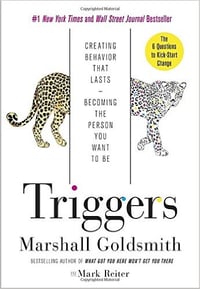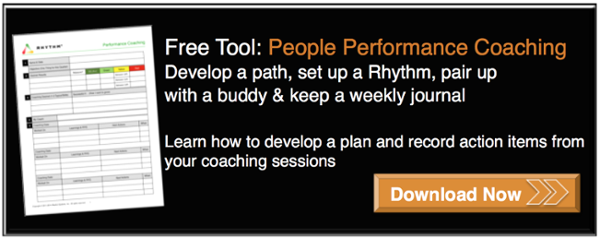Millions of employees around the world are feeling disengaged, depressed and dissatisfied with work. This isn’t a new problem, and there has been a lot of research and many programs and strategies developed to address the issue. Author, coach, and influential business thought leader, Marshall Goldsmith, suggested in a webinar that the problem with the typical approach to employee engagement is that it centers around what the company can do to engage employees rather than on what employees can do to engage themselves. He examined the research for his new book Triggers: Becoming the Person You Want to Be, and he found that the key to success in leadership development and employee engagement is the person rather than the program.
isn’t a new problem, and there has been a lot of research and many programs and strategies developed to address the issue. Author, coach, and influential business thought leader, Marshall Goldsmith, suggested in a webinar that the problem with the typical approach to employee engagement is that it centers around what the company can do to engage employees rather than on what employees can do to engage themselves. He examined the research for his new book Triggers: Becoming the Person You Want to Be, and he found that the key to success in leadership development and employee engagement is the person rather than the program.
Goldsmith cites research from Kouzes and Posner who found that the key variable for engagement was whether the person could live their own values at work, not whether the company had defined a set of institutional core values. As we’re fond of saying, it’s not about having the poster on your wall; core values will only help you engage your workforce if you are intentional about hiring people whose internal values are a fit for your company’s core values. The link to engagement is whether the person feels they can live out their own values in the workplace. Goldsmith also cited research that people who found meaning, happiness and satisfaction at work also tended to find the same in their home life. The reverse is true, too - people who were unhappy at work were also unhappy at home. This drives his point that engagement often has more to do with the individual than the environment.
So, if we aren’t feeling engaged and energized by our work, maybe instead of looking for a different job, our first step should be to look at ourselves. Most workers want to be happy… so, what’s stopping them? The reason most of us don’t make the changes we want in our lives or follow through on our personal and professional goals is that we become distracted by triggers that take us away from our goals; there is a huge gap between the “planner” and “doer” for most of us. We tend to underestimate how difficult it will be to accomplish a goal or how long it will take. Most importantly, we lack the structure and help that we as humans will need to be accountable to doing something differently.
Goldsmith recommends using a “daily question process” to help provide the structure and accountability that we need to be intentional about being the happier, more engaged person we always wanted to be. The process is simple; you write down a list of basic questions (the answers should be “yes,” “no,” or a number); the questions should focus on what you can do to make a positive difference for yourself and the world. They should be based on your values and what’s important to you. Some examples might be “How many pushups did you do today?” or “Were you kind to your partner?" You can use a spreadsheet for this or you can have an accountability coach email you everyday with your list of questions. It should only take you about two minutes a day to answer the questions, and in his studies he found that 89% of people reported improvement in at least one of the items they were trying to impact.
Here are the six questions that Goldsmith uses in his study:
- Did I do my best to be happy?
- Did I do my best to find meaning?
- Did I do my best to be fully engaged?
- Did I do my best to build positive relationships?
- Did I do my best to set clear goals?
- Did I do my best to make progress toward goal achievement?
What’s the application here for employee engagement? It’s easy to see how being accountable to answering these questions each day would bring these goals top of mind throughout the day and could impact a person’s overall feelings of satisfaction. But, how does that transfer to work? You can do the same exercise and answer the same questions with work as your context. Imagine you were going to a meeting and after you’d be tested on whether you did your best to be happy, find meaning, build positive relationships and be fully engaged. Chances are you’d approach that meeting with a different attitude. You’d be thinking, “how can I add value” or “how can I turn this boring meeting into something meaningful” rather than “when is it going to be over so I can get back to the real work.” How you show up and your expectation of what you’ll get out of the meeting greatly impact how you feel about the meeting and how engaged you are in that meeting. If you can turn on the engagement switch in your life, you can turn it on at work, too.
If the idea of answering questions each day doesn’t sound particularly appealing as a way to become more engaged in your life and work, there are other ways to set up the structure and help you need to stay disciplined around your personal and work goals. Finding a mentor at work or someone to help you stay accountable and reach your career goals is one way to provide structure; you can use our performance coaching tool to work with your coach on specific improvements you need to make to have the career you want. Also, you can set up a dashboard in Rhythm to monitor your personal development and career growth goals to help you stay focused and engaged. At Rhythm Systems, we set up a separate group for “Sharpening Our Saws” where people on the team record goals like reading for professional development, taking Spanish lessons, exercising, spending quality time with loved ones, etc. We status these every week (just like our regular Rhythm priorities and KPIs), and the team can comment to offer encouragement if someone’s not on track with the goals.
What are the questions you should be asking yourself each day that could increase your engagement, improve your productivity and allow you to live your core values every day?
Photo Credit: iStock by Getty Images



 LinkedIn
LinkedIn
 Facebook
Facebook
